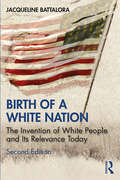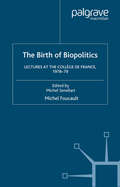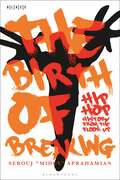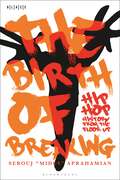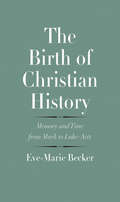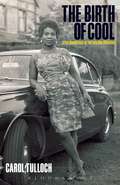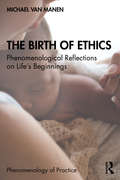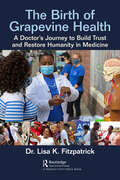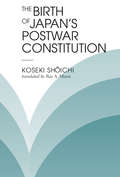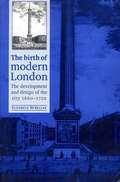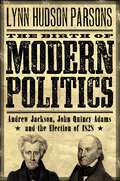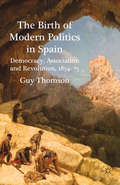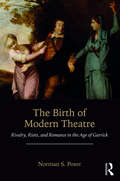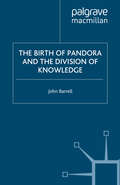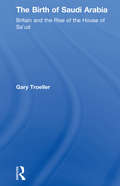- Table View
- List View
Birth of a White Nation: The Invention of White People and Its Relevance Today
by Jacqueline BattaloraBirth of a White Nation, Second Edition examines the social construction of race through the invention of white people. Surveying colonial North American law and history, the book interrogates the origins of racial inequality and injustice in American society, and details how the invention still serves to protect the ruling elite to the present day. This second edition documents the proliferation of ideas imposed and claimed throughout history that have conspired to give content, form, and social meaning to one’s racial classification. Beginning its expanded narrative with the development of diverse Native American societies through contact with European colonizers in the Tidewater region, and progressing to the emigration of Mexicans, Irish, and other "non-whites", this new edition addresses the ongoing production and reproduction of whiteness as a distinct and dominant social category. It also looks to the future by developing a new, applied framework for countering racial inequality and promoting greater awareness of anti-racist policies and practices.Birth of a White Nation will be of great interest to students, scholars, and general readers seeking to make sense of the dramatic racial inequities of our time and to forge an antiracist path forward.
Birth of a White Nation: The Invention of White People and Its Relevance Today
by Jacqueline BattaloraBirth of a White Nation, Second Edition examines the social construction of race through the invention of white people. Surveying colonial North American law and history, the book interrogates the origins of racial inequality and injustice in American society, and details how the invention still serves to protect the ruling elite to the present day. This second edition documents the proliferation of ideas imposed and claimed throughout history that have conspired to give content, form, and social meaning to one’s racial classification. Beginning its expanded narrative with the development of diverse Native American societies through contact with European colonizers in the Tidewater region, and progressing to the emigration of Mexicans, Irish, and other "non-whites", this new edition addresses the ongoing production and reproduction of whiteness as a distinct and dominant social category. It also looks to the future by developing a new, applied framework for countering racial inequality and promoting greater awareness of anti-racist policies and practices.Birth of a White Nation will be of great interest to students, scholars, and general readers seeking to make sense of the dramatic racial inequities of our time and to forge an antiracist path forward.
The Birth of Biopolitics: Lectures at the Collège de France, 1978-1979 (Michel Foucault, Lectures at the Collège de France)
by M. Foucault Arnold I. Davidson Graham BurchellFoucault continues on the theme of his 1978 course by focusing on the study of liberal and neo-liberal forms of government and concentrating in particular on two forms of neo-liberalism: German post-war liberalism and the liberalism of the Chicago School.
The Birth of Breaking: Hip-Hop History from the Floor Up (Black Literary and Cultural Expressions)
by Serouj "Midus" AprahamianThe untold story of how breaking – one of the most widely practiced dance forms in the world today – began as a distinctly African American expression in the Bronx, New York, during the 1970s. Breaking is the first and most widely practiced hip-hop dance in the world, with around one million participants in this dynamic, multifaceted artform – and, as of 2024, Olympic sport. Yet, despite its global reach and nearly 50-year history, stories of breaking's origins have largely neglected the African Americans who founded it. Dancer and scholar Serouj "Midus" Aprahamian offers, for the first time, a detailed look into the African American beginnings of breaking in the Bronx, New York. The Birth of Breaking challenges numerous myths and misconceptions that have permeated studies of hip-hop's evolution, considering the influence breaking has had on hip-hop culture. Including previously unseen archival material, interviews, and detailed depictions of the dance at its outset, this book brings to life this buried history, with a particular focus on the early development of the dance, the institutional settings where hip-hop was conceived, and the movement's impact on sociocultural conditions in New York City throughout the 1970s. By featuring the overlooked first-hand accounts of over 50 founding b-boys and b-girls alongside movement analysis informed by his embodied knowledge of the dance, Aprahamian reveals how indebted breaking is to African American culture, as well as the disturbing factors behind its historical erasure.
The Birth of Breaking: Hip-Hop History from the Floor Up (Black Literary and Cultural Expressions)
by Serouj "Midus" AprahamianThe untold story of how breaking – one of the most widely practiced dance forms in the world today – began as a distinctly African American expression in the Bronx, New York, during the 1970s. Breaking is the first and most widely practiced hip-hop dance in the world, with around one million participants in this dynamic, multifaceted artform – and, as of 2024, Olympic sport. Yet, despite its global reach and nearly 50-year history, stories of breaking's origins have largely neglected the African Americans who founded it. Dancer and scholar Serouj "Midus" Aprahamian offers, for the first time, a detailed look into the African American beginnings of breaking in the Bronx, New York. The Birth of Breaking challenges numerous myths and misconceptions that have permeated studies of hip-hop's evolution, considering the influence breaking has had on hip-hop culture. Including previously unseen archival material, interviews, and detailed depictions of the dance at its outset, this book brings to life this buried history, with a particular focus on the early development of the dance, the institutional settings where hip-hop was conceived, and the movement's impact on sociocultural conditions in New York City throughout the 1970s. By featuring the overlooked first-hand accounts of over 50 founding b-boys and b-girls alongside movement analysis informed by his embodied knowledge of the dance, Aprahamian reveals how indebted breaking is to African American culture, as well as the disturbing factors behind its historical erasure.
The Birth of Christian History: Memory and Time from Mark to Luke-Acts (The\anchor Yale Bible Reference Library)
by Eve-Marie BeckerThe first comprehensive account to explore the beginnings of early Christian history writing, tracing its origin to the Gospel of Mark and Luke-Acts When the Gospel writings were first produced, Christian thinking was already cognizant of its relationship to ancient memorial cultures and history-writing traditions. Yet, little has been written about exactly what shaped the development of early Christian literary memory. In this eye-opening new study, Eve-Marie Becker explores the diverse ways in which history was written according to the Hellenistic literary tradition, focusing specifically on the time during which the New Testament writings came into being: from the mid-first century until the early second century CE. While acknowledging cases of historical awareness in other New Testament writings, Becker traces the origins of this historiographical approach to the Gospel of Mark and Luke-Acts. Offering a bold new framework, Becker shows how the earliest Christian writings shaped “Christian” thinking and writing about history.
The Birth of Cool: Style Narratives of the African Diaspora
by Carol Tulloch Syd SheltonIt is broadly recognized that black style had a clear and profound influence on the history of dress in the twentieth century, with black culture and fashion having long been defined as 'cool'. Yet despite this high profile, in-depth explorations of the culture and history of style and dress in the African diaspora are a relatively recent area of enquiry. The Birth of Cool asserts that 'cool' is seen as an arbiter of presence, and relates how both iconic and 'ordinary' black individuals and groups have marked out their lives through the styling of their bodies.Focusing on counter- and sub-cultural contexts, this book investigates the role of dress in the creation and assertion of black identity. From the gardenia corsage worn by Billie Holiday to the work-wear of female African-Jamaican market traders, through to the home-dressmaking of black Britons in the 1960s, and the meaning of a polo-neck jumper as depicted in a 1934 self-portrait by African-American artist Malvin Gray Johnson, this study looks at the ways in which the diaspora experience is expressed through self-image.Spanning the late nineteenth century to the modern day, the book draws on ready-made and homemade fashion, photographs, paintings and films, published and unpublished biographies and letters from Britain, Jamaica, South Africa, and the United States to consider how personal style statements reflect issues of racial and cultural difference. The Birth of Cool is a powerful exploration of how style and dress both initiate and confirm change, and the ways in which they expresses identity and resistance in black culture.
The Birth of Cool: Style Narratives of the African Diaspora
by Carol Tulloch Syd SheltonIt is broadly recognized that black style had a clear and profound influence on the history of dress in the twentieth century, with black culture and fashion having long been defined as 'cool'. Yet despite this high profile, in-depth explorations of the culture and history of style and dress in the African diaspora are a relatively recent area of enquiry. The Birth of Cool asserts that 'cool' is seen as an arbiter of presence, and relates how both iconic and 'ordinary' black individuals and groups have marked out their lives through the styling of their bodies.Focusing on counter- and sub-cultural contexts, this book investigates the role of dress in the creation and assertion of black identity. From the gardenia corsage worn by Billie Holiday to the work-wear of female African-Jamaican market traders, through to the home-dressmaking of black Britons in the 1960s, and the meaning of a polo-neck jumper as depicted in a 1934 self-portrait by African-American artist Malvin Gray Johnson, this study looks at the ways in which the diaspora experience is expressed through self-image.Spanning the late nineteenth century to the modern day, the book draws on ready-made and homemade fashion, photographs, paintings and films, published and unpublished biographies and letters from Britain, Jamaica, South Africa, and the United States to consider how personal style statements reflect issues of racial and cultural difference. The Birth of Cool is a powerful exploration of how style and dress both initiate and confirm change, and the ways in which they expresses identity and resistance in black culture.
The Birth of Digital Human Rights: Digitized Data Governance as a Human Rights Issue in the EU (Information Technology and Global Governance)
by Rebekah DowdThis book considers contested responsibilities between the public and private sectors over the use of online data, detailing exactly how digital human rights evolved in specific European states and gradually became a part of the European Union framework of legal protections. The author uniquely examines why and how European lawmakers linked digital data protection to fundamental human rights, something heretofore not explained in other works on general data governance and data privacy. In particular, this work examines the utilization of national and European Union institutional arrangements as a location for activism by legal and academic consultants and by first-mover states who legislated digital human rights beginning in the 1970s. By tracing the way that EU Member States and non-state actors utilized the structure of EU bodies to create the new norm of digital human rights, readers will learn about the process of expanding the scope of human rights protections within multiple dimensions of European political space. The project will be informative to scholar, student, and layperson, as it examines a new and evolving area of technology governance – the human rights of digital data use by the public and private sectors.
The Birth of Ethics: Phenomenological Reflections on Life’s Beginnings (Phenomenology of Practice)
by Michael van ManenFrom the time of conception, through the gestation of pregnancy, to the birth of a newborn child exists an extraordinary, emergent ethics. How does this ethics come into being when a child is conceived? How does the appearance of ethics in pregnancy differ from its emergence after birth? How does the original meaning of ethics relate to modern morality in decision making? In this book, Michael van Manen explores these ethical moral complexities and conceptualizations of life’s beginnings. He delves into perennial and contemporary aspects of conception, pregnancy, and birth to present ethics as a fundamental phenomenon in the experiential encounter between parent and child. Even in the context of neonatal-perinatal medicine, where all manner of medical technologies and illnesses may potentially complicate the developing relation of parent and child, ethics is always already present yet also enigmatic in its origin. And yet, to approach ethical moral questions, we need to understand the inception of ethics. The Birth of Ethics: Phenomenological Reflections on Life’s Beginnings is an essential text not only for health professionals and researchers but also for parents, family members, and others who care and take responsibility for newborns in need of medical care.
The Birth of Ethics: Phenomenological Reflections on Life’s Beginnings (Phenomenology of Practice)
by Michael van ManenFrom the time of conception, through the gestation of pregnancy, to the birth of a newborn child exists an extraordinary, emergent ethics. How does this ethics come into being when a child is conceived? How does the appearance of ethics in pregnancy differ from its emergence after birth? How does the original meaning of ethics relate to modern morality in decision making? In this book, Michael van Manen explores these ethical moral complexities and conceptualizations of life’s beginnings. He delves into perennial and contemporary aspects of conception, pregnancy, and birth to present ethics as a fundamental phenomenon in the experiential encounter between parent and child. Even in the context of neonatal-perinatal medicine, where all manner of medical technologies and illnesses may potentially complicate the developing relation of parent and child, ethics is always already present yet also enigmatic in its origin. And yet, to approach ethical moral questions, we need to understand the inception of ethics. The Birth of Ethics: Phenomenological Reflections on Life’s Beginnings is an essential text not only for health professionals and researchers but also for parents, family members, and others who care and take responsibility for newborns in need of medical care.
The Birth of Feminism: Woman as Intellect in Renaissance Italy and England
by Sarah Gwyneth RossIn this illuminating work, surveying 300 years and two nations, Sarah Gwyneth Ross demonstrates how the expanding ranks of learned women in the Renaissance era presented the first significant challenge to the traditional definition of “woman” in the West. An experiment in collective biography and intellectual history, The Birth of Feminism focuses on nineteen learned women from the middle ranks of society who rose to prominence in the world of Italian and English letters between 1400 and 1680. Drawing both on archival material—wills, letters, and manuscript compositions, some presented here for the first time—and on printed writings, Ross gives us an unprecedented sense of educated early modern women’s lives. Sponsored and often educated by their learned fathers and other male relatives within a model that Ross terms “the intellectual family,” female authors publicized their works within the safety of family networks. These women, including Christine de Pizan, Laura Cereta, Margaret More Roper, Lucrezia Marinella, and Bathsua Makin, did not argue for women’s political equality, but they represented and often advocated women’s intellectual equality. Ross demonstrates that because of their education, these women had a renaissance during the Renaissance, and that in so doing they laid the foundation for the emancipation of womankind.
The Birth of Grapevine Health: A Doctor's Journey to Build Trust and Restore Humanity in Medicine
by Lisa K. FitzpatrickThe COVID-19 pandemic has taught the world many things, but one of the most crucial is the need to communicate tailored health information through trusted messengers effectively. The Birth of Grapevine Health chronicles the experiences of one physician, Dr. Lisa Fitzpatrick, a CDC-trained medical epidemiologist on a mission to deliver trusted health information to the Black community through Grapevine Health, a community and health outreach organization she started with the aim to improve patient engagement and health literacy in underserved communities through the digital delivery of tailored health messages. Fitzpatrick reveals why she began building an organization that, in 2020, appeared tailored for the COVID-19 pandemic long before that crisis unfolded across the globe. Frustrated by the lack of progress in addressing health inequity, Dr. Lisa moved into an under-resourced community to become proximal enough to better understand health inequity and the structural and policy changes needed to address it. She weaves her professional experiences with storytelling and lessons learned into a call to action for healthcare leaders, decisionmakers, and funders to move beyond data collection and shift toward action to focus on health prevention, move our health support further upstream and, ultimately, improve health outcomes for underserved communities. The Birth of Grapevine Health is part memoir, part health equity playbook, and offers a roadmap to actions needed to achieve health equity. At a time when health equity conversations seem ubiquitous, what sets The Birth of Grapevine Health apart is its embrace and integration of community voice. This book delivers deep insights and, at times, uncomfortable advice through the eyes of Black and brown patients and their communities about what it will take to achieve health equity.
The Birth of Grapevine Health: A Doctor's Journey to Build Trust and Restore Humanity in Medicine
by Lisa K. FitzpatrickThe COVID-19 pandemic has taught the world many things, but one of the most crucial is the need to communicate tailored health information through trusted messengers effectively. The Birth of Grapevine Health chronicles the experiences of one physician, Dr. Lisa Fitzpatrick, a CDC-trained medical epidemiologist on a mission to deliver trusted health information to the Black community through Grapevine Health, a community and health outreach organization she started with the aim to improve patient engagement and health literacy in underserved communities through the digital delivery of tailored health messages. Fitzpatrick reveals why she began building an organization that, in 2020, appeared tailored for the COVID-19 pandemic long before that crisis unfolded across the globe. Frustrated by the lack of progress in addressing health inequity, Dr. Lisa moved into an under-resourced community to become proximal enough to better understand health inequity and the structural and policy changes needed to address it. She weaves her professional experiences with storytelling and lessons learned into a call to action for healthcare leaders, decisionmakers, and funders to move beyond data collection and shift toward action to focus on health prevention, move our health support further upstream and, ultimately, improve health outcomes for underserved communities. The Birth of Grapevine Health is part memoir, part health equity playbook, and offers a roadmap to actions needed to achieve health equity. At a time when health equity conversations seem ubiquitous, what sets The Birth of Grapevine Health apart is its embrace and integration of community voice. This book delivers deep insights and, at times, uncomfortable advice through the eyes of Black and brown patients and their communities about what it will take to achieve health equity.
The Birth Of Japan's Postwar Constitution
by Koseki ShoichiThis 1989 Yoshino Sakuzo prize-winning book is essential reading for understanding Japans postwar constitution, political and social history, and foreign policy. In this, the most complete English account of the origins of Japans Constitution, the author presents new interpretations of the behind-the-scenes actors who shaped the Japanese Constitution: the petulant General Douglas MacArthur, Japanese defenders of the conservative order, Japanese liberal and socialist reformers, and moderate Allies sitting on the Far Eastern Commission. }This 1989 Yoshino Sakuzo prize-winning book is essential reading for understanding Japans postwar constitution, political and social history, and foreign policy. The most complete English account of the origins of Japans constitution, it analyzes the dramatic events of 19451946 that lead to the birth of Japans new constitution. Koseki Shoichi challenges t he simplicity of the current interpretation that General Douglas MacArthur in February 1946, faced with inept Japanese efforts at constitutional reform and Soviet interference through the Far Eastern Commission, secretly ordered his staff to write a constitution in seven days and then imposed it on Japan. Differentiating between the adoption procedure and the framing process, the author argues that the latter was varied, complicated, and rich, going beyond the actions of two nations and their representatives. It involved the clash of legal ideas, the conflicting efforts of individuals of different cultures and different political persuasions, and significant contributions by people with no connection to government.Drawing on Japanese, American, and Australian archives as well as recent scholarly research, Koseki presents new and stimulating interpretations of MacArthurs actions, the Ashida amendment of Article 9, Yoshidas role, and much more. Criticizing Japanese conservative defenders of the old order, he explores Japanese liberal and socialist ideas on constitutional reform and reevaluates the Far Eastern Commissions influence on MacArthurs policies and on the shaping of the basic principles of Japans antiwar constitution. }
The birth of modern London (Studies in Design and Material Culture)
by Christopher Breward Bill ShermanThe period 1660–1720 saw the foundation of modern London. The city was transformed post-Fire from a tight warren of medieval timber-framed buildings into a vastly expanded, regularised landscape of brick houses laid out in squares and spacious streets. This work for the first time examines in detail the building boom and the speculative developers who created that landscape. It offers a wealth of new information on their working practices, the role of craftsmen and the design thinking which led to the creation of a new prototype for English housing. The book concentrates on the mass-produced houses of 'the middling sort' which saw the adoption of classicism on a large scale in this country for the first time. McKellar shows, however, that the 'new city' maintained a surprising degree of continuity with existing patterns of urban used and traditional architecture. The book presents the late seventeenth and the early eighteenth century as a distinct phase in London's architectural development and offers a radical reinterpretations of the adoption of Renaissance styles and ideas at the level of the everyday, challenging conventional interpretations of their use and reception in this country.
The birth of modern London: Development And Design Of The City, 1660-1720 (Studies in Design and Material Culture)
by Christopher Breward Bill ShermanThe period 1660–1720 saw the foundation of modern London. The city was transformed post-Fire from a tight warren of medieval timber-framed buildings into a vastly expanded, regularised landscape of brick houses laid out in squares and spacious streets. This work for the first time examines in detail the building boom and the speculative developers who created that landscape. It offers a wealth of new information on their working practices, the role of craftsmen and the design thinking which led to the creation of a new prototype for English housing. The book concentrates on the mass-produced houses of 'the middling sort' which saw the adoption of classicism on a large scale in this country for the first time. McKellar shows, however, that the 'new city' maintained a surprising degree of continuity with existing patterns of urban used and traditional architecture. The book presents the late seventeenth and the early eighteenth century as a distinct phase in London's architectural development and offers a radical reinterpretations of the adoption of Renaissance styles and ideas at the level of the everyday, challenging conventional interpretations of their use and reception in this country.
The Birth of Modern Politics: Andrew Jackson, John Quincy Adams, and the Election of 1828 (Pivotal Moments in American History)
by Lynn Hudson ParsonsThe 1828 presidential election, which pitted Major General Andrew Jackson against incumbent John Quincy Adams, has long been hailed as a watershed moment in American political history. It was the contest in which an unlettered, hot-tempered southwestern frontiersman, trumpeted by his supporters as a genuine man of the people, soundly defeated a New England "aristocrat" whose education and political résumé were as impressive as any ever seen in American public life. It was, many historians have argued, the country's first truly democratic presidential election. It was also the election that opened a Pandora's box of campaign tactics, including coordinated media, get-out-the-vote efforts, fund-raising, organized rallies, opinion polling, campaign paraphernalia, ethnic voting blocs, "opposition research," and smear tactics. In The Birth of Modern Politics, Parsons shows that the Adams-Jackson contest also began a national debate that is eerily contemporary, pitting those whose cultural, social, and economic values were rooted in community action for the common good against those who believed the common good was best served by giving individuals as much freedom as possible to promote their own interests. The book offers fresh and illuminating portraits of both Adams and Jackson and reveals how, despite their vastly different backgrounds, they had started out with many of the same values, admired one another, and had often been allies in common causes. But by 1828, caught up in a shifting political landscape, they were plunged into a competition that separated them decisively from the Founding Fathers' era and ushered in a style of politics that is still with us today.
The Birth of Modern Politics: Andrew Jackson, John Quincy Adams, and the Election of 1828 (Pivotal Moments in American History)
by Lynn Hudson ParsonsThe 1828 presidential election, which pitted Major General Andrew Jackson against incumbent John Quincy Adams, has long been hailed as a watershed moment in American political history. It was the contest in which an unlettered, hot-tempered southwestern frontiersman, trumpeted by his supporters as a genuine man of the people, soundly defeated a New England "aristocrat" whose education and political résumé were as impressive as any ever seen in American public life. It was, many historians have argued, the country's first truly democratic presidential election. It was also the election that opened a Pandora's box of campaign tactics, including coordinated media, get-out-the-vote efforts, fund-raising, organized rallies, opinion polling, campaign paraphernalia, ethnic voting blocs, "opposition research," and smear tactics. In The Birth of Modern Politics, Parsons shows that the Adams-Jackson contest also began a national debate that is eerily contemporary, pitting those whose cultural, social, and economic values were rooted in community action for the common good against those who believed the common good was best served by giving individuals as much freedom as possible to promote their own interests. The book offers fresh and illuminating portraits of both Adams and Jackson and reveals how, despite their vastly different backgrounds, they had started out with many of the same values, admired one another, and had often been allies in common causes. But by 1828, caught up in a shifting political landscape, they were plunged into a competition that separated them decisively from the Founding Fathers' era and ushered in a style of politics that is still with us today.
The Birth of Modern Politics in Spain: Democracy, Association and Revolution, 1854-75
by G. ThomsonAn in-depth study of the reception of Democratic ideas in mid-19th Century Spain on the provincial and local level, and how they influenced the political process and fuelled the numerous conspiracies and insurrections directed at the Bourbon monarchy, between the failed uprisings in Spain in 1848 and the First Republic in 1873.
The Birth of Modern Theatre: Rivalry, Riots, and Romance in the Age of Garrick
by Norman S. PoserThe Birth of Modern Theatre: Rivalry, Riots, and Romance in the Age of Garrick is a vivid description of the eighteenth-century London theatre scene—a time when the theatre took on many of the features of our modern stage. A natural and psychologically based acting style replaced the declamatory style of an earlier age. The theatres were mainly supported by paying audiences, no longer by royal or noble patrons. The press determined the success or failure of a play or a performance. Actors were no longer shunned by polite society, some becoming celebrities in the modern sense. The dominant figure for thirty years was David Garrick, actor, theatre manager and playwright, who, off the stage, charmed London with his energy, playfulness, and social graces. No less important in defining eighteenth-century theatre were its audiences, who considered themselves full-scale participants in theatrical performances; if they did not care for a play, an actor, or ticket prices, they would loudly make their wishes known, sometimes starting a riot. This book recounts the lives—and occasionally the scandals—of the actors and theatre managers and weaves them into the larger story of the theatre in this exuberant age, setting the London stage and its leading personalities against the background of the important social, cultural, and economic changes that shaped eighteenth-century Britain. The Birth of Modern Theatre brings all of this together to describe a moment in history that sowed the seeds of today’s stage.
The Birth of Modern Theatre: Rivalry, Riots, and Romance in the Age of Garrick
by Norman S. PoserThe Birth of Modern Theatre: Rivalry, Riots, and Romance in the Age of Garrick is a vivid description of the eighteenth-century London theatre scene—a time when the theatre took on many of the features of our modern stage. A natural and psychologically based acting style replaced the declamatory style of an earlier age. The theatres were mainly supported by paying audiences, no longer by royal or noble patrons. The press determined the success or failure of a play or a performance. Actors were no longer shunned by polite society, some becoming celebrities in the modern sense. The dominant figure for thirty years was David Garrick, actor, theatre manager and playwright, who, off the stage, charmed London with his energy, playfulness, and social graces. No less important in defining eighteenth-century theatre were its audiences, who considered themselves full-scale participants in theatrical performances; if they did not care for a play, an actor, or ticket prices, they would loudly make their wishes known, sometimes starting a riot. This book recounts the lives—and occasionally the scandals—of the actors and theatre managers and weaves them into the larger story of the theatre in this exuberant age, setting the London stage and its leading personalities against the background of the important social, cultural, and economic changes that shaped eighteenth-century Britain. The Birth of Modern Theatre brings all of this together to describe a moment in history that sowed the seeds of today’s stage.
The Birth of Pandora: and the Division of Knowledge (Language, Discourse, Society)
by J. BarrellThis book brings together many of John Barrell's essays - some written especially for this volume - on the history and politics of culture in eighteenth-century Britain. It addresses a wide range of cultural practices - painting, sculpture, poetry, the law, the division of labour - discussing them in relation to such issues as sexuality, the body and representation and the distinction between public and private. The Birth of Pandora will interest all those involved with or interested in cultural history and cultural studies.
The Birth of Saudi Arabia: Britain and the Rise of the House of Sa'ud
by Gary TroellerFirst Published in 1976. Routledge is an imprint of Taylor & Francis, an informa company.
The Birth of Saudi Arabia: Britain and the Rise of the House of Sa'ud
by Gary TroellerFirst Published in 1976. Routledge is an imprint of Taylor & Francis, an informa company.
